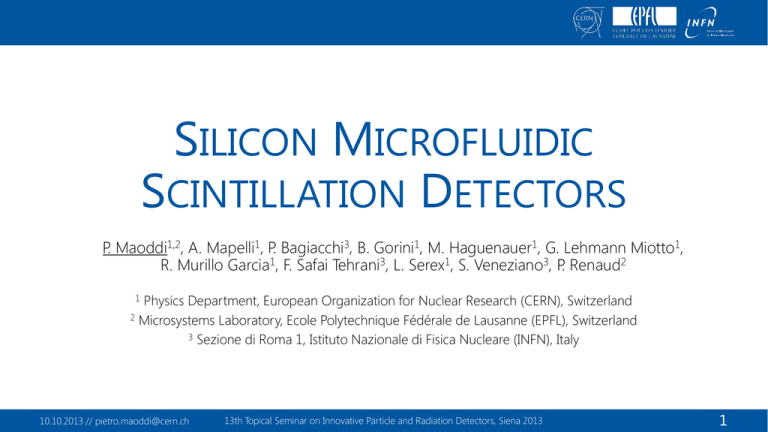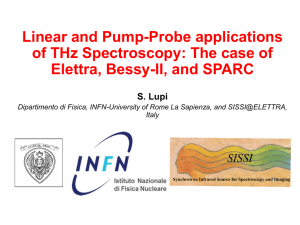Scintillation detectors based on silicon microfluidic channels
advertisement

SILICON MICROFLUIDIC SCINTILLATION DETECTORS P. Maoddi1,2, A. Mapelli1, P. Bagiacchi3, B. Gorini1, M. Haguenauer1, G. Lehmann Miotto1, R. Murillo Garcia1, F. Safai Tehrani3, L. Serex1, S. Veneziano3, P. Renaud2 Physics Department, European Organization for Nuclear Research (CERN), Switzerland 2 Microsystems Laboratory, Ecole Polytechnique Fédérale de Lausanne (EPFL), Switzerland 3 Sezione di Roma 1, Istituto Nazionale di Fisica Nucleare (INFN), Italy 1 10.10.2013 // pietro.maoddi@cern.ch 13th Topical Seminar on Innovative Particle and Radiation Detectors, Siena 2013 1 OUTLINE • Introduction • Microfluidic scintillation detectors: concept and previous work • Advantages and applications • Single layer devices • Fabrication technology • Experiments • Double layer devices • Fabrication technology • Experiments • Conclusions and outlook 10.10.2013 // pietro.maoddi@cern.ch 13th Topical Seminar on Innovative Particle and Radiation Detectors, Siena 2013 2 OPERATING PRINCIPLE Microchannel Scintillation • Microfluidic channel filled with liquid scintillator defining an array of waveguides • Photodetector pixel coupled to each channel end • Scintillation light guided along microchannel and detected For fine spatial resolution: small channels (10 µm – 1 mm) Photodetector array 10.10.2013 // pietro.maoddi@cern.ch microfluidics 13th Topical Seminar on Innovative Particle and Radiation Detectors, Siena 2013 3 FIRST PROTOTYPE MAPMT First prototype ( first shown at IPRD08 ) • Microchannels made by SU-8 photolithography • Gold reflective coating DAQ system 𝑁𝑝𝑒 = 1.6 20 mm (200 µm deep channel) 𝑁𝑝𝑒 𝑡 Photo: J. Daguin 10.10.2013 // pietro.maoddi@cern.ch ~8 mm-1 15 mm A. Mapelli PhD thesis (2011) 13th Topical Seminar on Innovative Particle and Radiation Detectors, Siena 2013 4 ADVANTAGES AND APPLICATIONS Advantages • Increased radiation resistance (liquid scintillator can be easily circulated in microchannels) • Microfabrication technology allows to make very thin detectors Potential applications individuated • Tracking/calorimetry in high energy physics • Beam monitoring in hadron therapy 10.10.2013 // pietro.maoddi@cern.ch 13th Topical Seminar on Innovative Particle and Radiation Detectors, Siena 2013 5 ONLINE BEAM MONITORING • Hadron therapy • Cancer treatment using hadron beams • Microfluidic detectors Particle beam • Very thin detectors can be made with microfabrication techniques • Very good radiation resistance expected Real-time monitoring of the beam during patient irradiation Thin microfluidic detector • Safer treatment • Optimized beam time use • Treatment cost reduction 10.10.2013 // pietro.maoddi@cern.ch 13th Topical Seminar on Innovative Particle and Radiation Detectors, Siena 2013 Patient under treatment 6 WHY SILICON? SU-8 photosensitive polymer • Easy micropatterning (one-step photolithography) • Good radiation resistance (comparable to Kapton) • Main challenge: incompatible with high temperature processing (required for other materials in the device, e.g. metal bonding) Silicon • Many reliable microfabrication techniques available • Better thermal and mechanical resistance • Possibility of tight integration of microchannels with semiconductor devices (photodetectors, electronics, …) All microfabrication activities performed at the EPFL Center for Micronanotechnology cleanroom Photo: V. Floraud 10.10.2013 // pietro.maoddi@cern.ch 13th Topical Seminar on Innovative Particle and Radiation Detectors, Siena 2013 7 DRY ETCHING AND SMOOTHING 2 µm • • • • 5 µm RF plasma reactor alternating SF6 (etching) and C4F8 (polymer coating) plasmas Vertical etching profile but resulting in «scalloping» Wet oxidation SiO2 has larger volume than Si surface features loss SiO2 removal with hydrofluoric acid smooth silicon 10.10.2013 // pietro.maoddi@cern.ch 13th Topical Seminar on Innovative Particle and Radiation Detectors, Siena 2013 8 DRY ETCHING OF MICROCHANNELS • Starting substrate: silicon wafer • Etching of microchannels via DRIE process 1. Patterning of silicon oxide as etching mask Microchannels etched in silicon 200 µm 2. Deep Reactive Ion Etching (alternated etching and passivation steps) 3. Smoothing by thick SiO2 growth and removal surfaces with suitable optical quality 10.10.2013 // pietro.maoddi@cern.ch 13th Topical Seminar on Innovative Particle and Radiation Detectors, Siena 2013 9 OPTICAL COATING AND BONDING • Deposition of reflective aluminum layer • Wafer-level bonding of metallized glass top 0.5 mm 0.5 mm 4. Reflective coating by aluminum sputtering 5. Preparation of top cover (aluminum patterning on glass wafer) Bonded channels section Two devices superimposed and staggered Pyrex 100 µm 6. Anodic bonding Total thickness ~0.96 mm 10.10.2013 // pietro.maoddi@cern.ch 13th Topical Seminar on Innovative Particle and Radiation Detectors, Siena 2013 10 OPTICAL AND FLUIDIC PACKAGING Microchannels cut open 15 mm 7. Dicing Channel ends are cut open Finished device 8. «Packaging» Thin glass window and fluidic connectors glued on chip 10.10.2013 // pietro.maoddi@cern.ch 13th Topical Seminar on Innovative Particle and Radiation Detectors, Siena 2013 11 Event count CHARACTERIZATION WITH PMTS Radioactive source (90Sr ) 𝑁𝑝𝑒 = 1.4 (180µm deep channel) 𝑁𝑝𝑒 𝑡 ~7.8 mm-1 Charge signal PMT Photoelectron spectrum fitted with: QDC Scintillating fiber (trigger) PMT Signal 𝑆 =𝑃+ 𝒫∗𝒩 Pedestal β- 10.10.2013 // pietro.maoddi@cern.ch 13th Topical Seminar on Innovative Particle and Radiation Detectors, Siena 2013 Gaussians convoluted with Poisson distribution (PMT response) 12 LIGHT YIELD • Expected light yield consistent with PMT measurements 𝑁𝑝𝑒 = 𝑁𝑠𝑐𝑖𝑛𝑡 ∙ 𝜀𝑡 ∙ 𝜀𝑖 ∙ 𝜀𝑞 = 2.07 (measured: 1.42) PMT quantum efficiency (~0.25) Interface optical efficiency (~0.9) Light transport efficiency (~0.03) Needs improvement! Average scintillation photons (~307) 50 µm Effects of surface roughness and defects at the liquid/glue/glass interface (lowering 𝑁𝑝𝑒 ) not calculated! 10.10.2013 // pietro.maoddi@cern.ch Possible solution: low refractive index dielectric cladding 13th Topical Seminar on Innovative Particle and Radiation Detectors, Siena 2013 13 BEAM MONITORING • High flux of relatively high energy particles • High light output expected • No need for high sensitivity photodetectors Energy distribution x x 10.10.2013 // pietro.maoddi@cern.ch Hamamatsu S8866-128-02 photodiode array 13th Topical Seminar on Innovative Particle and Radiation Detectors, Siena 2013 14 EXPERIMENTS WITH PHOTODIODES Microchannels 0.8 x (mm) 90Sr source (2.4 MBq) Readout system developed in collaboration with INFN Rome 0.7 0.18 ... Microchannel section Microchannels window on photodiodes Hamamatsu S8866-128-02 photodiode array (connected to DAQ board) Long integration time used (1 sec) Integrated light signal β- Photodiode (pixel) 0.8 Plastic support Pixel number (0 … 127) 10.10.2013 // pietro.maoddi@cern.ch 13th Topical Seminar on Innovative Particle and Radiation Detectors, Siena 2013 15 EXPERIMENTS WITH PHOTODIODES Problem: flux from radioactive source too low for scintillation photons to «sum-up» in the photodiodes • Test setup 90Sr source: ~104 e-/sec @ ~2 MeV/e• For comparison, proton therapy: ~1011 p+/sec @ ~100 MeV/p+ Conclusions: • Test setup with 90Sr source not suitable for readout with photodiodes • Test with actual beam envisioned to validate this kind of application 10.10.2013 // pietro.maoddi@cern.ch 13th Topical Seminar on Innovative Particle and Radiation Detectors, Siena 2013 16 DOUBLE L AYER MICROCHANNELS Patent filed in 2012, PCT/EP2012001980 y • Adding an orthogonal microchannel layer XY position resolution • Technological solution: patterning both sides of the silicon substrate X side x Y side 10.10.2013 // pietro.maoddi@cern.ch 13th Topical Seminar on Innovative Particle and Radiation Detectors, Siena 2013 17 WET ETCHING OF XY MICROCHANNELS • Starting substrate: silicon wafer • Etching of microchannels on both sides at the same time 1. Patterning of etching mask on both sides of the wafer 2. Etching of both sides of the wafer 3. Reflective coating by aluminum Sputtering on both sides 10.10.2013 // pietro.maoddi@cern.ch 13th Topical Seminar on Innovative Particle and Radiation Detectors, Siena 2013 18 PACKAGING OF DOUBLE L AYER CHIPS • One-step bonding of 3 wafers stack • Dry etching for inter-layer connection Si Bonding interface Al 200 nm Silicon or pyrex cover wafers Si 4. Bonding of 3 wafers stack by aluminum thermocompression Fluid inlet Top layer 5. Channel cutting and gluing of two glass windows and fluidic connectors as before 10.10.2013 // pietro.maoddi@cern.ch 13th Topical Seminar on Innovative Particle and Radiation Detectors, Siena 2013 Bottom layer 80 µm inter-layer Si 19 EXPERIMENTS WITH XY DEVICES (preliminary) Radioactive source (90Sr ) 𝑁𝑝𝑒 = 1.0 X PMT Y PMT X layer (150 µm) Data acquisition from both layers at the same time Trigger PMT Trigger fiber (preliminary) β- Y layer (150 µm) 𝑁𝑝𝑒 = 0.9 𝑁𝑝𝑒 𝑡 ~6 mm-1 (Glass windows and tubing not shown) 10.10.2013 // pietro.maoddi@cern.ch 13th Topical Seminar on Innovative Particle and Radiation Detectors, Siena 2013 20 CONCLUSIONS AND OUTLOOK Conclusions • Different processes for microchannel patterning on silicon developed • Single and double layer devices demonstrated with PMT readout • Issues on tests with photodiode array readout Perspectives • Beam tests with photodiode readout • Integration of on-chip a-Si:H photodiodes • Readout system based on SiPMs 10.10.2013 // pietro.maoddi@cern.ch 13th Topical Seminar on Innovative Particle and Radiation Detectors, Siena 2013 21 OTHER TECHNOLOGIES ... aside from silicon, research on polymeric microchannels also ongoing! 200 µm ~0.03% X0 110 µm total thickness (30 + 50 + 30) 20 x 20 mm 10.10.2013 // pietro.maoddi@cern.ch 13th Topical Seminar on Innovative Particle and Radiation Detectors, Siena 2013 22 THANK YOU 10.10.2013 // pietro.maoddi@cern.ch 13th Topical Seminar on Innovative Particle and Radiation Detectors, Siena 2013 23 STAGGERING • Staggered channels for improved geometrical coverage 100 µm staggering Pyrex grinded to 100 µm Total thickness ~0.96 mm 10.10.2013 // pietro.maoddi@cern.ch (focal plane in the middle) 13th Topical Seminar on Innovative Particle and Radiation Detectors, Siena 2013 24 MATERIAL BUDGET X0 (mm) Single layer thickness (mm) Silicon 94 Double layer thickness (mm) 0.2 (0.21% X0) 0.58 (0.62% X0) 0.5 (0.4% X0) 0.5 (0.21% X0) 0.18 (0.04% X0) 0.3 (0.06% X0) Aluminum 89 0.0002 (negligible) 0.0004 (negligible) Total 0.65% to 0.8% X0 0.89% to 1.2% X0 Pyrex 126 EJ-305 ~500 Excess material can be ground down to 100 – 50 µm Single layer: 0.12% to 0.28% X0 Double layer: 0.24% to 0.5% X0 0.5 mm min 10.10.2013 // pietro.maoddi@cern.ch max 13th Topical Seminar on Innovative Particle and Radiation Detectors, Siena 2013 25 FLUIDIC OPERATION Detector area (mm2) Depth (mm) Width (mm) N channels Internal volume (µL) Hydraulic Resistance (bar s µL-1) Refill time @ ΔP = 1 bar 12.8 x 12.8 0.18 0.7 16 25.8 0.0042 ~ 100 ms 12.8 x 12.8 0.18 0.1 64 14.7 0.5 ~7s 204.8 x 204.8 0.18 0.7 256 6450 1.1 ~ 2h 24h operation at ΔP = 1 bar: less than 80 mL of scintillator needed depth Channel section width 10.10.2013 // pietro.maoddi@cern.ch 13th Topical Seminar on Innovative Particle and Radiation Detectors, Siena 2013 26
